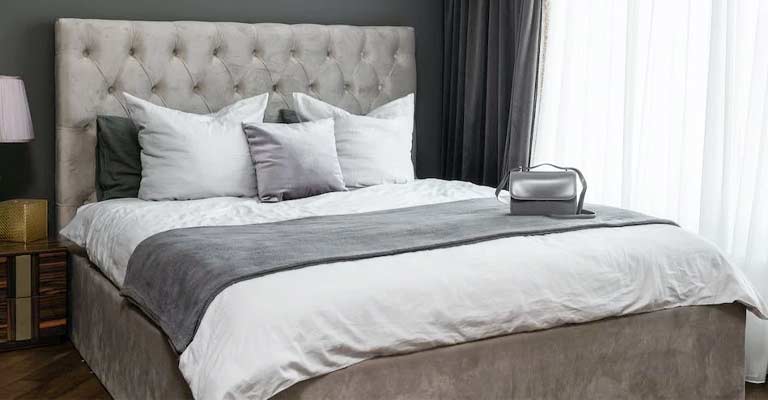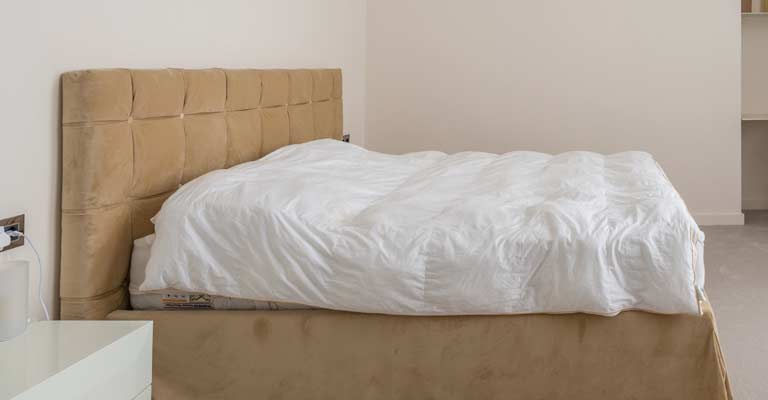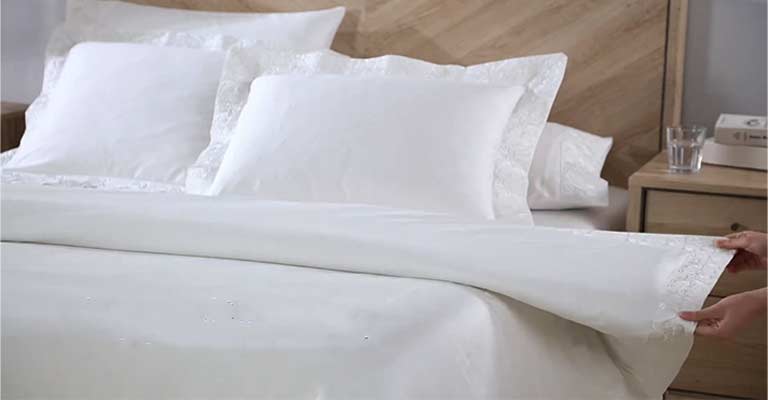A comforter is good to use as soon as you buy it—no need for a duvet cover or any extra covering. But if you want, you can put a duvet cover on it.
Some folks do this to protect their comforter from getting dirty. You can also use the comforter as the insert for the duvet if you like.
How To Use A Duvet Cover With A Comforter
It’s a breeze to use a duvet cover with your comforter. Simply slip your comforter inside the duvet cover, button it up, and voilà—your comforter is shielded from dirt, and there’s no risk of it slipping out.
Cleaning is a snap too; just toss the duvet cover in with your regular laundry every one to two weeks. With a duvet cover, the need for a top sheet is eliminated, making sleeping and bed-making much simpler.
Changing duvet covers isn’t as tricky as you might think, especially if you follow our helpful guide. Scandinavian duvet covers even come with inside corner ties, ensuring a secure fit that won’t shift around once it’s on.
If your comforter doesn’t provide enough warmth during colder months due to less fill, a duvet cover can come to the rescue.
European linen duvet covers are thermoregulating, offering coolness in warm weather and warmth in cooler temperatures. Unlike comforters with a fixed design, duvet covers offer flexibility.
Comforters, with designs printed directly on the surface, can’t be changed if you get tired of them. Instead of accumulating bulky comforters in your linen closet, opt for a quick style refresh by covering your comforter with a duvet cover.
Bonus: duvet covers take up less space, giving you the freedom to switch up styles without the storage hassle.
How Can I Put A Comforter In A Duvet Cover?
Putting a comforter inside a duvet cover can be a bit tricky, but here’s a step-by-step guide to help you:
Spread Out the Duvet Cover:

Lay your duvet cover flat on the bed with the opening at the foot of the bed.
Turn the Duvet Cover Inside Out:
Turn the duvet cover inside out, so the pattern or plain side is on the inside.
Place the Comforter Inside:
Lay your comforter on top of the duvet cover. Make sure that the corners of the comforter match up with the corners of the duvet cover.
Attach the Top Corners:
Reach inside the duvet cover and grab the top corners of the comforter. Match these corners with the top corners of the duvet cover and secure them together.
Shake and Fluff:
Hold the top corners and give the duvet cover a good shake. This helps the comforter settle into the cover.
Work Your Way Down:

While holding the top corners, start rolling the duvet cover down towards the foot of the bed. As you roll, the comforter should be pulled inside.
Secure the Bottom Corners:
Once you’ve reached the foot of the bed, reach inside and secure the bottom corners of the comforter with the duvet cover.
Button, Snap, or Zip:
Close the opening of the duvet cover using buttons, snaps, or a zipper. This will keep the comforter securely inside.
Shake and Adjust:
Give the entire duvet a good shake to distribute the comforter evenly inside. Reach inside and adjust the corners to ensure a smooth fit.
Fluff and Arrange:

Once the comforter is evenly distributed, fluff it up and arrange it inside the duvet cover for a neat and comfortable appearance.
The Main Difference Between A Comforter And A Duvet
Many folks use “duvet” and “comforter” interchangeably, but they’re actually quite different.
A duvet is a kind of bedding usually filled with natural or synthetic fibers like down, wool, or feathers. On the flip side, a comforter is more like a quilted blanket filled with synthetic fibers.
So, what sets them apart? The big difference is that a comforter is a single piece of bedding, while a duvet involves two separate parts — an insert and a cover.
Comforters are typically quilted with evenly distributed filling, whereas a duvet has an insert that acts as the fill, fitting into the duvet cover like a pillow in a pillowcase.
If you want, you can totally use a duvet cover on a comforter, maybe to keep it from getting dirty. And here’s a cool twist: a comforter can even work as the insert for a duvet.
Although using a duvet cover on a comforter isn’t a must, some people go for it to keep their comforter in top shape. It’s all about personal preference!
Drawbacks Of Using A Comforter
The primary downside of using a comforter is the challenge of keeping it clean. Even if a stylish patterned comforter conceals dirt and grime visually, the experience of sleeping under it can be unpleasant.
Accidentally spill your morning coffee on the comforter, and your options are limited—either attempt to fit it into a small residential washing machine (unlikely) or opt for professional cleaning.
However, with each cleaning session, the inner fill tends to flatten, diminishing its insulating effectiveness.
While many people use a top sheet as a protective layer under their comforter, this isn’t foolproof.
As you move during the night, displacing the top sheet, the comforter becomes exposed to your body and the surroundings. Tightly tucked top sheets may feel restrictive, potentially leading to discomfort or even leg cramps.
If you manage to free yourself from the top sheet, it often ends up crumpled or entangled with the rest of your bedding.
In Scandinavian practice, there’s no top sheet; instead, a duvet with a secured duvet cover is the sole bedding item. This ensures a sanitary and secure choice, allowing unrestricted movement without the hassles of a top sheet.
Choosing The Perfectly Fitting Duvet Cover
When in the market for a duvet cover for your comforter, steer clear of size labels like “full” or “king.” Comforters often outsize duvets, so it’s crucial to measure your comforter for an accurate fit when selecting a duvet cover.








